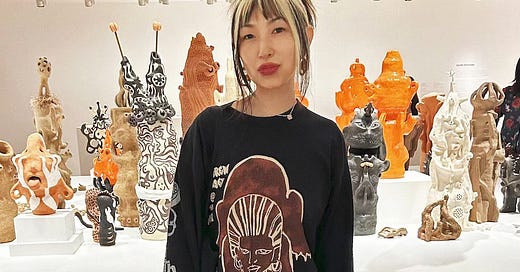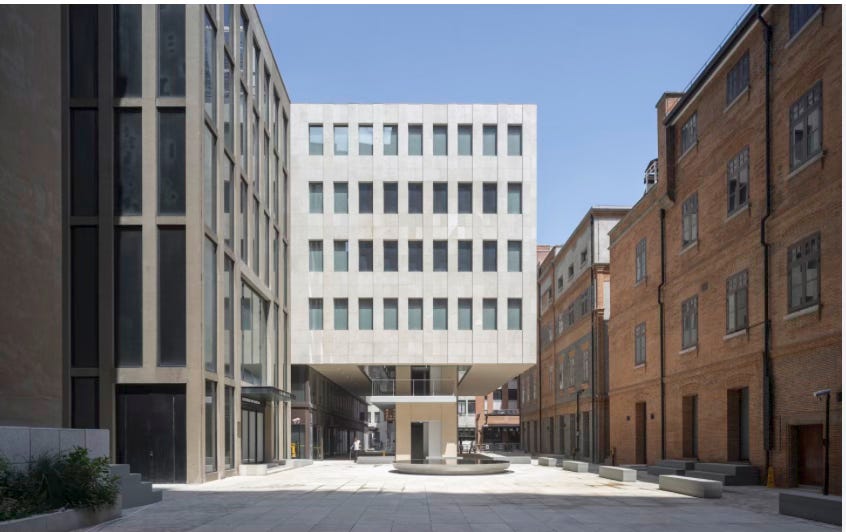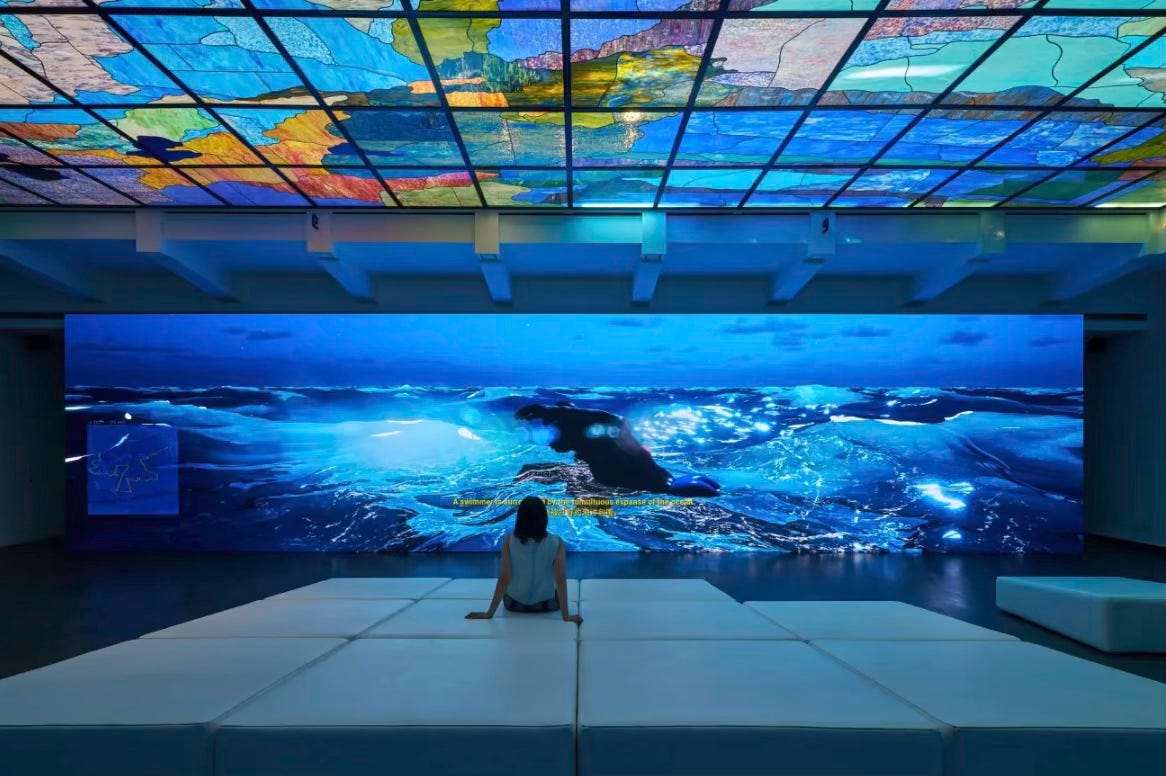
Born in Shanghai, but educated in America – at Berkeley, the School of the Art Institute of Chicago, Massachusetts Institute of Technology, and Northwestern University – Zhu-Nowell is the complete east-west combo, well placed to make connections between China and the United States. Yet this not the limit of her ambitions, she has embarked on a “big research project around the Pacific,” which brings the art of Australia and Polynesia into her plans. She was visiting Brisbane in December for this year’s Asia-Pacific Triennial.
To come looking for artists from the Asia-Pacific to exhibit in Shanghai is breaking new ground. “When it comes to exhibitions,” she admits, “China, like the USA, can be very self-absorbed.”
I’ve referred to Zhu-Nowell as “she”, but I could just as easily have said “they”, as she/they has/have embraced a non-binary identity. To avoid the endless confusion occasioned by plural pronouns, I’m going to acknowledge her non-binary preference but use “she”, as there is little doubt the curator was born and bred female.
Being non-binary, or changing your legal name to “X”, is a mark of Zhu-Nowell’s ultra-contemporary aspirations. She wants us to know she is ready to take on the most broadranging, multi-faceted projects.
Upon completing her studies in the United States, Zhu-Nowell went to work for the Solomon R. Guggenheim Museum, New York, where she helped organise the landmark 2008 survey, Art and China after 1989: Theater of the World. Her Years at the Guggenheim introduced her to the international art world and fired a desire to return to Asia, where she felt there was more energy and opportunity.
She also became a protégé of Carolyn Christov-Bakargiev, one of the most internationally connected curators at work today. Christov-Bakargiev, who was artistic director for the Sydney Biennale of 2010, among other projects, recognised Zhu-Nowell’s potential and has helped bring her to wider attention.
The Rockbund is not the biggest museum in Shanghai, but it is one of the most significant. Built in 1932 for the Royal Asiatic Society, this Art Deco building became a contemporary not-for-profit art museum in 2010, under the private ownership of Lynn and Thomas Ou, whose wealth lies in many different enterprises. The inaugural director, Frenchman, Larys Frogier, set an adventurous precedent by showcasing international artists. Zhu-Nowell is aiming to extend the museum’s focus in a series of research-based shows that relate to the history and identity of the region.
Acclaimed British architect, David Chipperfield, undertook the initial renovation of the building, which was completed in 2010, but his firm has been working on the Rockbund precinct for more than 17 years. There are 11 historic buildings and six new ones included in a district that incorporates specialty stores and boutiques, coffee shops, bookshops, and even a street stall that helps dogs find new owners. It’s quite unlike anything to be found anywhere else in China, and the RAM is the central attraction.
Zhu-Nowell is intensely conscious of the unique nature of the site, located at the end of the Bund, between Suzhou Creek and Nanjing East Road. It has all the makings of a sophisticated tourist magnet, with no crushing need to dumb down or play the populist card. In Australia it’s more than likely that a precinct of this kind would be cluttered with franchise shops and fast-food restaurants.
In her second year in the job, Zhu-Nowell’s “big research” around the Pacific will translate into a series of exhibitions and events, involving South-East Asia, Latin America, Australia and Canada. Her first task was “to understand Shanghai”, beginning with a show called Mount Analogue, by Shanghai artist, Hu Yun - a complex, multi-layered presentation spread across the fourth, fifth and sixth floors of the museum. Combining sculptural installation, found objects and photography, the show intertwined the artist’s family history with the greater history of the region, using works produced over the previous decade.
The second floor of the museum is playing host to AUUUUDITORIUM, a program of talks, performances, workshops and parties, guest curated by Singaporean artist, Ming Wong slated to run until February 2026.
The current exhibition, Best Synthetic Answer, by American artist-poet, Rindon Johnson (until 6 April) recreates a virtual voyage across the Pacific from San Francisco to Shanghai in real-time. The artist’s original intention was to make the journey by boat, but soon realised this would have been a voyage to oblivion – albeit an interesting allusion to the Dutch artist, Bas Jan Ader, who disappeared in 1975, after setting out to sail single-handedly across the North-Atlantic. AI has helped create a more vivid experience.
Such a work is unconventional and testing for audiences, which is precisely what Zhu-Nowell wants. In Shanghai she says, she found a city in which people are willing to meet the challenge, turning up in numbers for each new event. The more delicate problem for any museum in China is to ensure your program wins the approval of the government, which demands to know details of all proposed exhibitions.
“People might call it censorship,” she says, “but the rule is that you have to get a permit if you are putting on a show for the public. You give the authorities a disc with all the relevant material, and you’ll usually receive permission within 15 days. They’re very prompt. If they don’t understand something they’ll ask for further clarification. This happened to us in relation to a photo of a library in Armenia, where all the book titles were in Armenian. We needed to send a translation.”
“In China you have avoid drawing undue attention. That’s very important, but it’s not the nightmare you might imagine because the bureaucrats are very open to negotiation. We had a show last year in which there was some nudity involved. We explained it was completely non-sexual nudity and they said that was OK.”
“It’s not so much about what they might personally accept, it’s more what viewers might think, because the last thing they want is a public outcry. A colleague in New York recently told me: ‘I wish we had a system like that because some of the work shown here is very upsetting!’”
The balancing act Zhu-Nowell is undertaking finds her trying to extend public perceptions about art and culture, while not going out of her way to offend. She is attempting to build bridges between China and the rest of the world while putting the local community first. Most crucially, she is presiding over a network in which the visual arts are but one part of a lifestyle project. One might spend an hour in the museum, but an entire day in the Rockbund precinct.
The key for any contemporary gallery director in China may be to treat every limitation as an invitation to find innovative, creative solutions. From an Australian perspective we need to overcome our reservations and recognise that emerging figures such as Zhu-Nowell are re-opening doors for us in China that have been closed in recent years. There’s so much to be gained from a revived cultural exchange with our powerful, problematic neighbour that we need to focus on the positives and seize those opportunities when they arise.
Published in the Australian Financial Review, 17 January 2025





